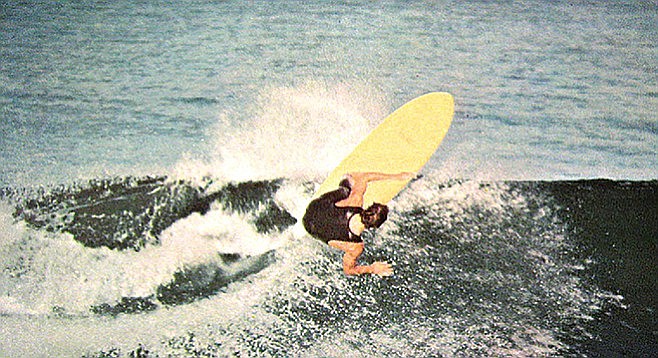 Facebook
Facebook
 X
X
 Instagram
Instagram
 TikTok
TikTok
 Youtube
Youtube

When Jim Mullin wrote about “San Diego Surf Lingo” for the Reader in 1976, most surfers in our area were riding seven-foot single fin surfboards, smaller twin fin, Fishes, or the newly revived longboards. Progressive moves at the time were off-the-lips and roundhouse cutbacks while bottom turns, tube rides, and noserides were still in vogue.
A new surfboard cost about $125 and Gordon & Smith and Hansen were the largest surf manufacturers in town. International Professional Surfers (IPS) had just been launched, and Australia’s Peter Townend was its first professional world champion. There was no women’s tour until 1977, when San Diego native Margo Oberg won the title.
Surfing has changed dramatically in the past 43 years. New words were required to describe the evolution of the surfboards and the moves performed on them.
While some of Mullin’s terms like "dawn patrol,” “feathering,” “stoked,” and “gnarly” are still regularly spoken, others like “BSB” and “body flyaway” have fallen from common usage.
The following are part of a surfer’s language in 2019:
Carve: A hard turn
Snap: Radical direction change
Thruster: Three-finned surfboard
Mini Simmons: A short twin fin popularized by San Diego standout, Richard Kevin, and modeled after the surfboards of 1950s legendary board builder, Bob Simmons, who drowned near Windansea Beach
Shacked: To ride inside a breaking wave. AKA tubed, barreled or locked in
Slab: An extremely thick and powerful wave
Bomb: Big wave
Doggy Door: The exit point from a tubing wave
Pigdog: Backside rail grab, usually in the tube
Air/Aerial: A move borrowed from skateboarding where surfer and surfboard are launched above the wave. Aerials were in their infancy in the mid-70s and only made possible by use of smaller, lighter surfboards


When Jim Mullin wrote about “San Diego Surf Lingo” for the Reader in 1976, most surfers in our area were riding seven-foot single fin surfboards, smaller twin fin, Fishes, or the newly revived longboards. Progressive moves at the time were off-the-lips and roundhouse cutbacks while bottom turns, tube rides, and noserides were still in vogue.
A new surfboard cost about $125 and Gordon & Smith and Hansen were the largest surf manufacturers in town. International Professional Surfers (IPS) had just been launched, and Australia’s Peter Townend was its first professional world champion. There was no women’s tour until 1977, when San Diego native Margo Oberg won the title.
Surfing has changed dramatically in the past 43 years. New words were required to describe the evolution of the surfboards and the moves performed on them.
While some of Mullin’s terms like "dawn patrol,” “feathering,” “stoked,” and “gnarly” are still regularly spoken, others like “BSB” and “body flyaway” have fallen from common usage.
The following are part of a surfer’s language in 2019:
Carve: A hard turn
Snap: Radical direction change
Thruster: Three-finned surfboard
Mini Simmons: A short twin fin popularized by San Diego standout, Richard Kevin, and modeled after the surfboards of 1950s legendary board builder, Bob Simmons, who drowned near Windansea Beach
Shacked: To ride inside a breaking wave. AKA tubed, barreled or locked in
Slab: An extremely thick and powerful wave
Bomb: Big wave
Doggy Door: The exit point from a tubing wave
Pigdog: Backside rail grab, usually in the tube
Air/Aerial: A move borrowed from skateboarding where surfer and surfboard are launched above the wave. Aerials were in their infancy in the mid-70s and only made possible by use of smaller, lighter surfboards
Comments